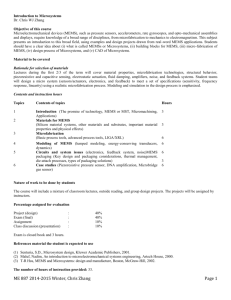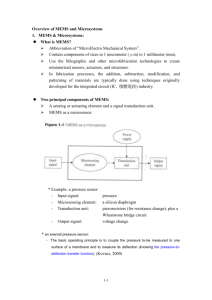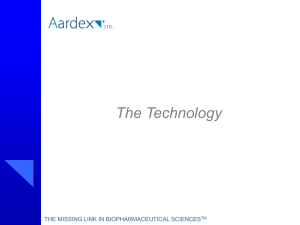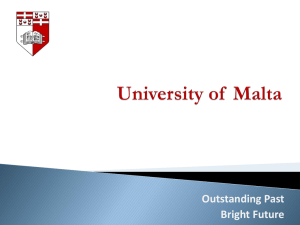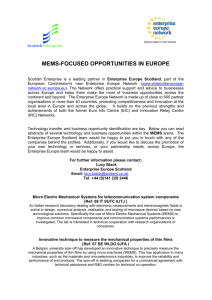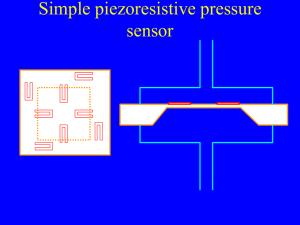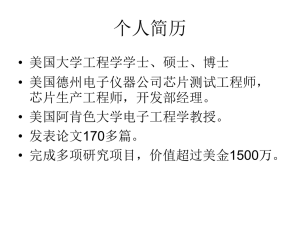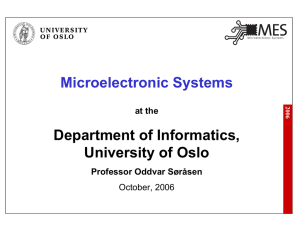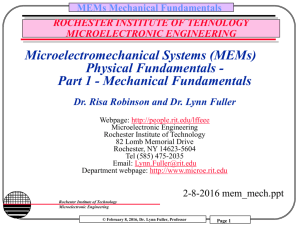EE 543 Fundamentals of Microfabrication and MEMS (3)
advertisement
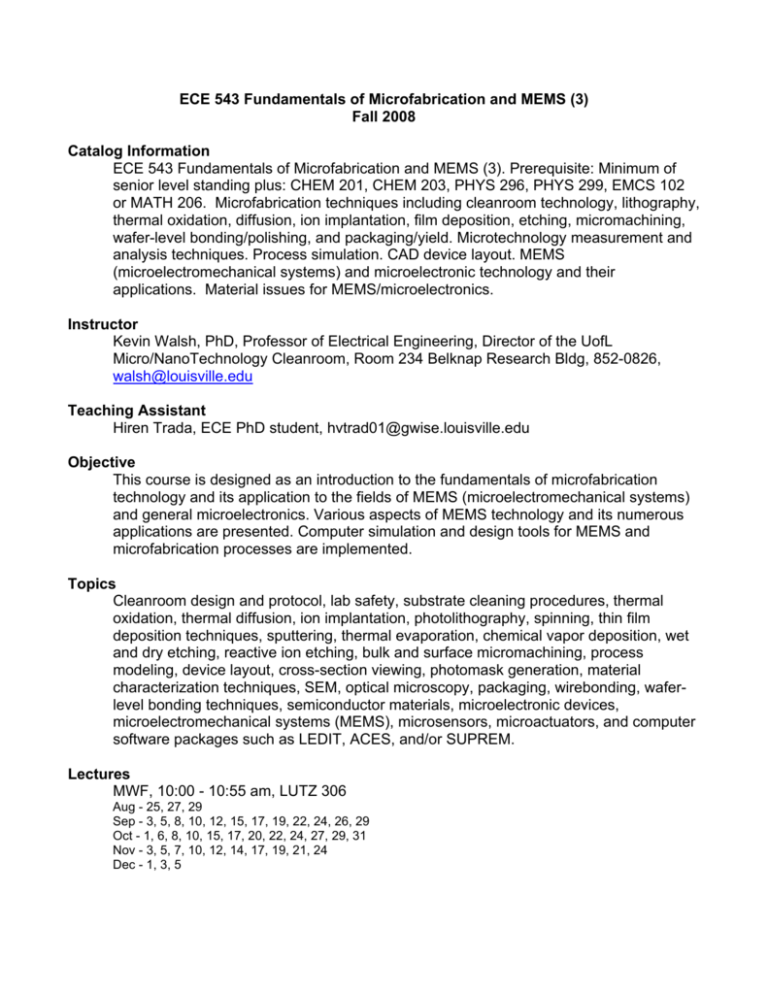
ECE 543 Fundamentals of Microfabrication and MEMS (3) Fall 2008 Catalog Information ECE 543 Fundamentals of Microfabrication and MEMS (3). Prerequisite: Minimum of senior level standing plus: CHEM 201, CHEM 203, PHYS 296, PHYS 299, EMCS 102 or MATH 206. Microfabrication techniques including cleanroom technology, lithography, thermal oxidation, diffusion, ion implantation, film deposition, etching, micromachining, wafer-level bonding/polishing, and packaging/yield. Microtechnology measurement and analysis techniques. Process simulation. CAD device layout. MEMS (microelectromechanical systems) and microelectronic technology and their applications. Material issues for MEMS/microelectronics. Instructor Kevin Walsh, PhD, Professor of Electrical Engineering, Director of the UofL Micro/NanoTechnology Cleanroom, Room 234 Belknap Research Bldg, 852-0826, walsh@louisville.edu Teaching Assistant Hiren Trada, ECE PhD student, hvtrad01@gwise.louisville.edu Objective This course is designed as an introduction to the fundamentals of microfabrication technology and its application to the fields of MEMS (microelectromechanical systems) and general microelectronics. Various aspects of MEMS technology and its numerous applications are presented. Computer simulation and design tools for MEMS and microfabrication processes are implemented. Topics Cleanroom design and protocol, lab safety, substrate cleaning procedures, thermal oxidation, thermal diffusion, ion implantation, photolithography, spinning, thin film deposition techniques, sputtering, thermal evaporation, chemical vapor deposition, wet and dry etching, reactive ion etching, bulk and surface micromachining, process modeling, device layout, cross-section viewing, photomask generation, material characterization techniques, SEM, optical microscopy, packaging, wirebonding, waferlevel bonding techniques, semiconductor materials, microelectronic devices, microelectromechanical systems (MEMS), microsensors, microactuators, and computer software packages such as LEDIT, ACES, and/or SUPREM. Lectures MWF, 10:00 - 10:55 am, LUTZ 306 Aug - 25, 27, 29 Sep - 3, 5, 8, 10, 12, 15, 17, 19, 22, 24, 26, 29 Oct - 1, 6, 8, 10, 15, 17, 20, 22, 24, 27, 29, 31 Nov - 3, 5, 7, 10, 12, 14, 17, 19, 21, 24 Dec - 1, 3, 5 Required Textbooks Introduction to Microelectronic Fabrication by Richard C. Jaeger WWW Material UofL MicroTechnology Web Site www.mems.louisville.edu www.louisville.edu/micronano Introduction to Microengineering by Dr. Daniel Banks www.dbanks.demon.co.uk/ueng/ Microsystems, Microsensors & Microactuators by Dr. Daniel Banks www.dbanks.demon.co.uk/ueng/ Introduction to Microengineering - Supplement by Dr. Daniel Banks www.ee.surrey.ac.uk/Personal/D.Banks/roughgui.html MUMPS Design Handbook by Cronos (Koester, Mahadevan, Shishkoff and Markus) http://www.memscap.com/en_mumps.html www.memsrus.com/cronos/svcsmumps.html www.memsrus.com/cronos/mumps.pdf References Semiconductor Devices: Physics and Technology by S. M. Sze Semiconductor Integrated Circuit Processing Technology by Runyan and Bean Fundamentals of Microfabrication by Marc Madou An Introduction to Microelectromechanical Systems Engineering by Nadim Maluf Micromachined Transducers Sourcebook by Greg Kovacs Physical Design of CMOS Integrated Circuits Using L-EDIT by J.P. Uyemura Exams 4 Exams (including the Final) Evaluation Homework (25%), best 3 exams (75%) Course Grade A+ A AB+ B BC+ C CD+ D DF 97 - 100 93 – 96.99 90 – 92.99 87 – 89.99 83 – 86.99 80 – 82.99 77 – 79.99 73 – 76.99 70 – 72.99 67 – 69.99 63 – 66.99 60 – 62.99 < 59.99 Prerequisite by Topic 1. Basic concepts of college physics 2. Basic concepts of college chemistry 3. Basic concepts of college calculus 4. Chemistry and physics laboratory experience Content 1. Cleanroom principles (1 class) 2. Microfabrication processes (18 classes) 3. Measurement and analysis techniques (3 classes) 4. MEMS technology (6 classes) 5. MEMS applications (3 classes) 6. Microelectronic applications (2 classes) 7. Materials for MEMS and microelectronics (2 classes) 8. Process modeling (2 class) 9. Device layout (1 class) 10. MUMPs and L-EDIT (2 class) 11. Examinations (3 classes) Computer Usage L-EDIT, ACES, SUPREM, and/or MATHCAD. Laboratory Projects None Estimated ABET Category Content Engineering science: 2 credits or 67%, Engineering design: 1 credits or 33% ACADEMIC and PROFESSIONAL INTEGRITY: You are expected to act professionally and ethically, in accordance with the Code of Student Rights and Responsibilities (UofL Undergraduate Catalog, Fall 2004 - Summer 2006, p.16; or on the Web, at http://www.louisville.edu/student/services/registrar/0406catalog.pdf (see especially, Section 5. Academic Dishonesty and Section 6. Discipline Procedures for Academic Dishonesty), and relevant sections of the Codes of Ethics of the relevant professional societies: the Association for Computing Machinery (ACM), the Institute of Electrical and Electronics Engineers (IEEE) and the National Society of Professional Engineers (NSPE). Cheating of any form, including plagiarism (defined in the Code of Student Rights and Responsibilities, Section 5.E. as "Representing the words or ideas of someone else as one's own in any academic exercise, ... [examples follow in the Catalog, p. 16]," can result in disciplinary action, including an F in the course and suspension/expulsion from the School and University. Cases involving cheating will be dealt with in accordance with the Speed School Procedures for Dealing with Breaches in Academic Integrity. ABET COURSE OUTCOMES: At the completion of ECE543, the student should be able to accomplish the following. 1. Be able to answer short qualitative questions about semiconductor fabrication techniques. 2. Be able to perform thermal oxidation calculations using Fick’s 1st law of diffusion modeling equations, as well as with oxidation graphs. 3. Be able to perform calculations using the complementary error function and Gaussian thermal diffusion modeling equations for both constant and limited source diffusions and driveins. 4. Be able to perform calculations using the ion implantation Gaussian modeling equations. 5. Be able to answer short qualitative and quantitative questions about the various thin-film deposition techniques, including evaporation, sputtering, CVD and epitaxy. 6. Be able to answer short qualitative and quantitative questions about microelectronic interconnect strategies. 7. Be able to answer short qualitative and quantitative questions about microelectronic packaging and yield. 8. Be able to answer short qualitative and quantitative questions about MEMS processes, MEMS devices and their applications. 9. Be able to layout a MEMS device using a CAD software package, such as LEDIT. 10. Be able to model fabrication processes using a CAD software package, such as ACES or SUPREM.


